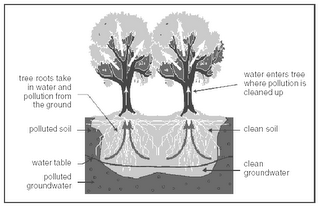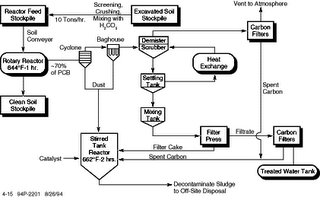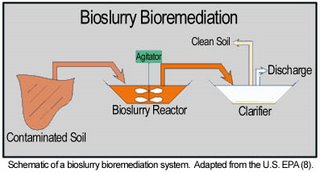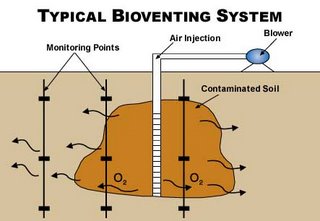






Soil Remediation Technologies
Some recently asked about my experience with soil remediation technologies. Actually it is very little. I only faced one case when we had big deviation and we had to to ask for actions. And a specialized company has been appointed to the task. Of course I have been involved in monitoring the process. Anyway, this is all the knowledge I have at this moment. If You need details just drop me a line.
Bioventing – Injecting oxygen into the ground in order to improve aerobic
biodegradation of contaminants. This is a long term cleanup option lasting from several
months to years. Bioventing is an experimental and innovative technology being
investigated and is used at several cleanup sites.
Purpose: Destruction aid
Pros: Successfully used to improve the remediation of soils contaminated with organic
compounds
Cons: May not improve degradation of chlorinated compounds
In situ/ex situ: In-situ
Contaminants remediated: BTEX compounds, nonhalogenated VOCs, some pesticides,
and wood preservatives
Dehalogenation - The use of chemicals to remove halogens (chlorine, bromine, etc.)
from contaminants. The by-product of dehalogenation is a non-toxic salt, partial
volatilization or decomposition of the contaminant. This is a short to medium term
method of remediation.
Purpose: Contaminant destruction/transformation
Pros: Good for low volume and low concentration contamination, successful in treating
PCB’s
Cons: May not be cost-effective for large treatment volumes, high clay and moisture
content increase costs. Requires air emission equipment and other treatment equipment
In situ/ex situ: Ex situ
Contaminants remediated: VOCs, SVOCs
Fluid/vapor extraction - Liquid and gas are removed from the ground using a high
vacuum system in extraction wells. Treatment of the removed contaminants is required.
Purpose: Removal
Pros: May shorten cleanup time at sites with VOC and fuel contamination
Cons: May not work well at heterogeneous sites, water and vapor must be treated
In situ/ex situ: Ex situ
Contaminants remediated: VOCs, some SVOCs
Geotechnical Systems- use of building foundations, storage facilities, etc. to minimize
exposure to contaminants and prevent rainwater from entering the wastes and creating
leachate. The building acts as a cap.
Purpose: Containment
Pros: Reduced remediation costs (separate remediation processes are not required, the
structure provides the containment)
Cons: Does not reduce contaminant volume, toxicity or mobility, if groundwater is
contaminated vertical walls may be required increasing costs
In situ/ex situ: In situ
Contaminants remediated: All
Incineration – Burning wastes in order to destroy contaminants by volatilization and
combustion.
Purpose: Contaminant destruction
Pros: Proven technology, destroys large number of contaminants
Cons: Only one off-site incinerator approved for PCB and dioxin, potential transportation
costs, bottom ash may require stabilization if heavy metals are incinerated, requires
excavation, additional treatment may be required for soils with volatile metals
In situ/ex situ: Ex situ
Contaminants remediated: VOCs, SVOCs, fuels and explosives
Landfill Cap/Brownfields Cap - a covering over a site that minimizes exposure to
contaminants and prevents rainwater from entering the wastes and creating leachate.
There are 3 major types of landfill caps. A RCRA Subtitle C landfill cap is for hazardous
waste landfills, a RCRA Subtitle D landfill cap is used on sanitary landfills. The last type
of cap is an asphalt, concrete, or topsoil cap.
biodegradation of contaminants. This is a long term cleanup option lasting from several
months to years. Bioventing is an experimental and innovative technology being
investigated and is used at several cleanup sites.
Purpose: Destruction aid
Pros: Successfully used to improve the remediation of soils contaminated with organic
compounds
Cons: May not improve degradation of chlorinated compounds
In situ/ex situ: In-situ
Contaminants remediated: BTEX compounds, nonhalogenated VOCs, some pesticides,
and wood preservatives
Dehalogenation - The use of chemicals to remove halogens (chlorine, bromine, etc.)
from contaminants. The by-product of dehalogenation is a non-toxic salt, partial
volatilization or decomposition of the contaminant. This is a short to medium term
method of remediation.
Purpose: Contaminant destruction/transformation
Pros: Good for low volume and low concentration contamination, successful in treating
PCB’s
Cons: May not be cost-effective for large treatment volumes, high clay and moisture
content increase costs. Requires air emission equipment and other treatment equipment
In situ/ex situ: Ex situ
Contaminants remediated: VOCs, SVOCs
Fluid/vapor extraction - Liquid and gas are removed from the ground using a high
vacuum system in extraction wells. Treatment of the removed contaminants is required.
Purpose: Removal
Pros: May shorten cleanup time at sites with VOC and fuel contamination
Cons: May not work well at heterogeneous sites, water and vapor must be treated
In situ/ex situ: Ex situ
Contaminants remediated: VOCs, some SVOCs
Geotechnical Systems- use of building foundations, storage facilities, etc. to minimize
exposure to contaminants and prevent rainwater from entering the wastes and creating
leachate. The building acts as a cap.
Purpose: Containment
Pros: Reduced remediation costs (separate remediation processes are not required, the
structure provides the containment)
Cons: Does not reduce contaminant volume, toxicity or mobility, if groundwater is
contaminated vertical walls may be required increasing costs
In situ/ex situ: In situ
Contaminants remediated: All
Incineration – Burning wastes in order to destroy contaminants by volatilization and
combustion.
Purpose: Contaminant destruction
Pros: Proven technology, destroys large number of contaminants
Cons: Only one off-site incinerator approved for PCB and dioxin, potential transportation
costs, bottom ash may require stabilization if heavy metals are incinerated, requires
excavation, additional treatment may be required for soils with volatile metals
In situ/ex situ: Ex situ
Contaminants remediated: VOCs, SVOCs, fuels and explosives
Landfill Cap/Brownfields Cap - a covering over a site that minimizes exposure to
contaminants and prevents rainwater from entering the wastes and creating leachate.
There are 3 major types of landfill caps. A RCRA Subtitle C landfill cap is for hazardous
waste landfills, a RCRA Subtitle D landfill cap is used on sanitary landfills. The last type
of cap is an asphalt, concrete, or topsoil cap.
Purpose: Containment
Pros: Asphalt/concrete cap is low cost, been approved at numerous sites
Cons: Does not reduce contaminant volume, toxicity or mobility, if groundwater is
contaminated vertical walls may be required increasing costs, cap may develop leaks over
time
In situ/ex situ: In situ
Contaminants remediated: All
Natural Attenuation (IT) – Allows nature to reduce or remove the level of contaminants
in the ground. Some examples of natural attenuation are biodegradation, dilution,
dispersion or adsorption in the soil. When analyzing this method for use exposure
pathways and property use must be looked at closely.
Purpose: Contaminant destruction, dilution and/or containment
Pros: Low maintenance, low cost
Cons: Typically a slow process, long term monitoring of the site required, may require
extensive site characterization
In situ/ex situ: In situ
Contaminants remediated: Some VOCs, BTEX compounds
Off-site disposal – Soil is excavated and transported to an off-site disposal location
which meets regulatory requirements for hazardous waste disposal. The waste may
require pre-treatment prior to acceptance by the disposal site.
Purpose: Containment
Pros: Proven method, relatively cheap
Cons: Cost may increase due to shipping to a permitted facility, regulatory agencies
prefer treatment, waste may require treatment prior to disposal
In situ/ex situ: Ex situ
Contaminants remediated: All
Pros: Asphalt/concrete cap is low cost, been approved at numerous sites
Cons: Does not reduce contaminant volume, toxicity or mobility, if groundwater is
contaminated vertical walls may be required increasing costs, cap may develop leaks over
time
In situ/ex situ: In situ
Contaminants remediated: All
Natural Attenuation (IT) – Allows nature to reduce or remove the level of contaminants
in the ground. Some examples of natural attenuation are biodegradation, dilution,
dispersion or adsorption in the soil. When analyzing this method for use exposure
pathways and property use must be looked at closely.
Purpose: Contaminant destruction, dilution and/or containment
Pros: Low maintenance, low cost
Cons: Typically a slow process, long term monitoring of the site required, may require
extensive site characterization
In situ/ex situ: In situ
Contaminants remediated: Some VOCs, BTEX compounds
Off-site disposal – Soil is excavated and transported to an off-site disposal location
which meets regulatory requirements for hazardous waste disposal. The waste may
require pre-treatment prior to acceptance by the disposal site.
Purpose: Containment
Pros: Proven method, relatively cheap
Cons: Cost may increase due to shipping to a permitted facility, regulatory agencies
prefer treatment, waste may require treatment prior to disposal
In situ/ex situ: Ex situ
Contaminants remediated: All
Soil Vapor Extraction (SVE) – A method of removing volatile and some semivolatile
organic contaminants from nonsaturated soil (vadose zone) by applying a vacuum to the
soil through extraction wells. The contaminants are removed from the ground to undergo
further treatment.
Purpose: Remove contaminants from the ground
Pros: Presumptive or generic remedy, relatively inexpensive, may increase
bioremediation when used in conjunction with air sparging, no excavation required,
highly effective in VOC removal
Cons: Treatment time slows in heterogeneous soils, heating the soil and air sparging may
be required, need to control air emissions
In situ/ex situ: In situ
Contaminants remediated: VOCs, some SVOCs
Soil Flushing – A process where a solution is injected in the ground in order to move
the contaminants to an area where they may be extracted from the ground and treated.
This is a developing technology which so far has seen limited success.
Purpose: Aid in making contaminants readily accessible for treatment
Pros: Portable technology, excavation not required
Cons: Limited success, groundwater flow must be understood completely to prevent
spreading contamination further
In situ/ex situ: In situ
Contaminants remediated: VOCs, SVOCs, some metals, fuels, pesticides
organic contaminants from nonsaturated soil (vadose zone) by applying a vacuum to the
soil through extraction wells. The contaminants are removed from the ground to undergo
further treatment.
Purpose: Remove contaminants from the ground
Pros: Presumptive or generic remedy, relatively inexpensive, may increase
bioremediation when used in conjunction with air sparging, no excavation required,
highly effective in VOC removal
Cons: Treatment time slows in heterogeneous soils, heating the soil and air sparging may
be required, need to control air emissions
In situ/ex situ: In situ
Contaminants remediated: VOCs, some SVOCs
Soil Flushing – A process where a solution is injected in the ground in order to move
the contaminants to an area where they may be extracted from the ground and treated.
This is a developing technology which so far has seen limited success.
Purpose: Aid in making contaminants readily accessible for treatment
Pros: Portable technology, excavation not required
Cons: Limited success, groundwater flow must be understood completely to prevent
spreading contamination further
In situ/ex situ: In situ
Contaminants remediated: VOCs, SVOCs, some metals, fuels, pesticides
Thermal desorption – Contaminants with low boiling points are vaporized by heating
wastes to moderate temperatures. Steam injection, electrical resistance heating and radiofrequency
heating may be used to raise soil temperatures. These temperatures range from
200° to 1000°_F depending on the contaminant to be vaporized. Thermal desorption is
only an aid in contaminant, it is typically used in conjunction with SVE in order to
increase the amount of contaminants removed from the soil.
Purpose: Aid in removing contaminants from the ground
Pros: Steam injection effectively removes petroleum hydrocarbons (BTEX), electrical
heating works well in fine grained soils
Cons: Innovative technology, full recovery of contaminant may be difficult, may not
work well in heterogeneous soils, high moisture content in soil increases costs, requires
treatment of off-gas
In situ/ex situ: Both may be used in situ or ex situ following excavation
Contaminants remediated: SVOCs, PAHs, PCBs and pesticides. May also be effective in
separating organics from coal tar wastes, refinery wastes, wood-treating wastes, paint
wastes and synthetic rubber processing waste.
wastes to moderate temperatures. Steam injection, electrical resistance heating and radiofrequency
heating may be used to raise soil temperatures. These temperatures range from
200° to 1000°_F depending on the contaminant to be vaporized. Thermal desorption is
only an aid in contaminant, it is typically used in conjunction with SVE in order to
increase the amount of contaminants removed from the soil.
Purpose: Aid in removing contaminants from the ground
Pros: Steam injection effectively removes petroleum hydrocarbons (BTEX), electrical
heating works well in fine grained soils
Cons: Innovative technology, full recovery of contaminant may be difficult, may not
work well in heterogeneous soils, high moisture content in soil increases costs, requires
treatment of off-gas
In situ/ex situ: Both may be used in situ or ex situ following excavation
Contaminants remediated: SVOCs, PAHs, PCBs and pesticides. May also be effective in
separating organics from coal tar wastes, refinery wastes, wood-treating wastes, paint
wastes and synthetic rubber processing waste.
Soil Washing – Soil is excavated and washed with water to remove contaminants.
Additives may be added to the water to enhance contaminant removal. The soil may
have to go through several remediation cycles to remove the contaminant. The wash
water must then undergo treatment to remediate the contaminants. The cleaned soil may
then be used as fill on site.
Purpose: Contaminant removal
Pros: cost effective, can reduce volume of contaminated soil
Cons: washing solution may be difficult to formulate for complex waste mixtures, soil
may require pretreatment, washing fluid requires treatment, organics may be difficult to
remove from clay-size particles
In situ/ex situ: Ex-situ
Contaminants removed: SVOC, fuels, heavy metals
Additives may be added to the water to enhance contaminant removal. The soil may
have to go through several remediation cycles to remove the contaminant. The wash
water must then undergo treatment to remediate the contaminants. The cleaned soil may
then be used as fill on site.
Purpose: Contaminant removal
Pros: cost effective, can reduce volume of contaminated soil
Cons: washing solution may be difficult to formulate for complex waste mixtures, soil
may require pretreatment, washing fluid requires treatment, organics may be difficult to
remove from clay-size particles
In situ/ex situ: Ex-situ
Contaminants removed: SVOC, fuels, heavy metals
Solvent extraction (IT) – Soil is excavated, screened to remove rocks and debris, and
then added to an extraction unit. In the extraction unit a solvent is added to the soil in
order to remove organic contaminants and segregate the different fractions (ie. water, oil
and soil layers). The mixture of water, solids, and solvent absorb different contaminants.
Each fraction is then separated and processed in order to remediate the contaminants that
collect in them.
Purpose: Contaminant removal
Pros: Reduces waste volume, operates without air emissions equipment
Cons: Inorganic contaminants may affect removal of solvents, systems may be complex
increasing engineering costs, extensive pretreatment of soil may be required
In situ/ex situ: Ex situ
Contaminants removed: organic contaminants from paint wastes, synthetic rubber
process wastes, coal tar wastes, drilling muds, wood treating wastes, pesticide/insecticide
wastes, and oily wastes
Stabilization/Solidification - Using cement, concrete, chemical fixation, etc to stabilize
or physically bind contaminants. The solid mass limits the solubility or mobility of the
contaminants though it doesn't destroy them.
Purpose: Containment
Pros: Relatively cheap, established vendor base,
Cons: Some processes may increase waste volume, solidified material may affect future
site use, depth of contamination may affect options
In situ/ex situ: Both
Contaminants remediated: Metals, radionuclides
then added to an extraction unit. In the extraction unit a solvent is added to the soil in
order to remove organic contaminants and segregate the different fractions (ie. water, oil
and soil layers). The mixture of water, solids, and solvent absorb different contaminants.
Each fraction is then separated and processed in order to remediate the contaminants that
collect in them.
Purpose: Contaminant removal
Pros: Reduces waste volume, operates without air emissions equipment
Cons: Inorganic contaminants may affect removal of solvents, systems may be complex
increasing engineering costs, extensive pretreatment of soil may be required
In situ/ex situ: Ex situ
Contaminants removed: organic contaminants from paint wastes, synthetic rubber
process wastes, coal tar wastes, drilling muds, wood treating wastes, pesticide/insecticide
wastes, and oily wastes
Stabilization/Solidification - Using cement, concrete, chemical fixation, etc to stabilize
or physically bind contaminants. The solid mass limits the solubility or mobility of the
contaminants though it doesn't destroy them.
Purpose: Containment
Pros: Relatively cheap, established vendor base,
Cons: Some processes may increase waste volume, solidified material may affect future
site use, depth of contamination may affect options
In situ/ex situ: Both
Contaminants remediated: Metals, radionuclides
Biodegradation or Bioremediation – Breaking down of contaminants by fungi, bacteria,
and other microbes. The microbes use the contaminants as food, typically producing
carbon dioxide, water and cells as the byproducts of the degradation. Some contaminants
may only be partially degraded to another substance. These substances may be more
toxic than the original contaminant in some cases. The microbes may be introduced into
the ground or may be native organisms.
Purpose: Contaminant degradation
Pros: Low maintenance, destroys contaminants, utilizes natural processes
Cons: Organism growth dependent on many factors, toxic by-products may be produced
In situ/ex situ: Both
Contaminants remediated: Fuels, VOCs, SVOCs
Phytoremediation (IT) – Plants and trees are used to remove contaminants from the
ground in phytoremediation. This may be accomplished by the uptake of the
contaminants by plants and trees which is called phytoextraction. Rhizofiltration
involves plants grown in a greenhouse using contaminated water as a water source. The
plants perform phytoextraction in a greenhouse rather than onsite. Phytodegradation
breaks down organic contaminants by enzymes which are secreted by the plants.
Phytovolatilization may occur where contaminants pass through the plant and evaporate
to the atmosphere.
Purpose: contaminant destruction, containment,
Pros: Plants and trees look nice, relatively cheap
Cons: Works at shallow depths (root depth), contaminants may collect in leaves
In situ/ex situ: In situ
Contaminants remediated: Fuels, VOCs, SVOCs, metals
and other microbes. The microbes use the contaminants as food, typically producing
carbon dioxide, water and cells as the byproducts of the degradation. Some contaminants
may only be partially degraded to another substance. These substances may be more
toxic than the original contaminant in some cases. The microbes may be introduced into
the ground or may be native organisms.
Purpose: Contaminant degradation
Pros: Low maintenance, destroys contaminants, utilizes natural processes
Cons: Organism growth dependent on many factors, toxic by-products may be produced
In situ/ex situ: Both
Contaminants remediated: Fuels, VOCs, SVOCs
Phytoremediation (IT) – Plants and trees are used to remove contaminants from the
ground in phytoremediation. This may be accomplished by the uptake of the
contaminants by plants and trees which is called phytoextraction. Rhizofiltration
involves plants grown in a greenhouse using contaminated water as a water source. The
plants perform phytoextraction in a greenhouse rather than onsite. Phytodegradation
breaks down organic contaminants by enzymes which are secreted by the plants.
Phytovolatilization may occur where contaminants pass through the plant and evaporate
to the atmosphere.
Purpose: contaminant destruction, containment,
Pros: Plants and trees look nice, relatively cheap
Cons: Works at shallow depths (root depth), contaminants may collect in leaves
In situ/ex situ: In situ
Contaminants remediated: Fuels, VOCs, SVOCs, metals

0 Comments:
Post a Comment
<< Home